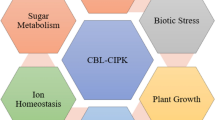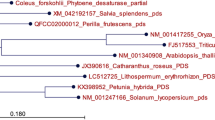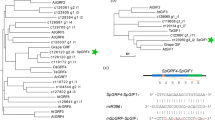Abstract
Abiotic stresses including water deficit severely limits crop yields in the semi-arid tropics. In chickpea, annual losses of over 3.7 million tones have been estimated to be due to water deficit conditions alone. Therefore, major efforts are needed to improve its tolerance to water deficit, and genetic engineering approaches provide an increasing hope for this possibility. We have used transgenic technology for the introduction of an osmoregulatory gene P5CSF129A encoding the mutagenized Δ1-pyrroline-5-carboxylate synthetase (P5CS) for the overproduction of proline. A total of 49 transgenic events of chickpea were produced with the 35S:P5CSF129A gene through Agrobacterium tumefaciens-mediated gene transfer through the use of axillary meristem explants. Eleven transgenic events that accumulated high proline (2–6 folds) were further evaluated in greenhouse experiments based on their transpiration efficiency (TE), photosynthetic activity, stomatal conductance, and root length under water stress. Almost all the transgenic events showed a decline in transpiration at lower values of the fraction of transpirable soil water (dryer soil), and extracted more water than their untransformed parents. The accumulation of proline in the selected events was more pronounced that increased significantly in the leaves when exposed to water stress. However, the overexpression of P5CSF129A gene resulted only in a modest increase in TE, thereby indicating that the enhanced proline had little bearing on the components of yield architecture that are significant in overcoming the negative effects of drought stress in chickpea.




Similar content being viewed by others
References
Alia, Saradhi PP, Mohanty P (1993) Proline in relation to free radical production in seedlings of Brassica juncea raised under sodium chloride stress. Plant Soil 155:497–500
Bates LS, Waldren RP, Teare ID (1973) Rapid determination of free proline for water-stress studies. Plant Soil 39:205–207
Blum A (1996) Crop responses to drought and the interpretation of adaptation. Plant Growth Regul 20:135–148
Blum A, Ebercon A (1976) Genotypic responses in sorghum to drought stress III. Free proline accumulation and drought resistance. Crop Sci 16:428–431
Blum A, Mayer J, Gozlan G (1983) Associations between plant production and some physiological components of drought resistance in wheat. Plant Cell Environ 6:219–225
Christian JHB (1955) The influence of nutrition on the water relations of Salmonella oranienburg. Aust J Biol Sci 8:75–81
Delauney AJ, Verma DPS (1993) Proline biosynthesis and osmoregulation in plants. Plant J 4:215–223
Dhindsa RS, Plumb-Dhindsa P, Thorpe TA (1981) Leaf senescence: correlated with increased levels of membrane permeability and lipid peroxidation, and decreased levels of superoxide dismutase and catalase. J Exp Bot 32:93–101
Heath RL, Packer L (1968) Photoperoxidation in isolated chloroplasts I. Kinetics and stoichiometry of fatty acid peroxidation. Arch Biochem Biophy 125:189–198
Hmida-Sayari A, Gargouri-Bouzid R, Bidani A, Jaoua L, Savouré A, Jaoua S (2005) Overexpression of Δ1-pyrroline-5-carboxylate synthetase increases proline production and confers salt tolerance in transgenic potato plants. Plant Sci 169:746–752
Hong Z, Lakkineni K, Zhang Z, Verma DPS (2000) Removal of feedback inhibition of 1-pyrroline-5-carboxylate synthetase results in increased proline accumulation and protection of plants from osmotic stress. Plant Physiol 122:1129–1136
Hu CA, Delauney AJ, Verma DPS (1992) A bifunctional enzyme (Δ1-pyrroline-5-carboxylate synthetase) catalyzes the first two steps in proline biosynthesis in plants. Proc Nat Acad Sci USA 89:9354–9358
Jayanand B, Sudarsanam G, Sharma KK (2003) An efficient protocol for the regeneration of whole plants of chickpea (Cicer arietinum L.) by using axillary meristem explants derived from in vitro germinated seedlings. In Vitro Cell Dev Biol Plant 39:171–179
Kar S, Basu D, Das S et al (1997) Expression of Cry1A(c) gene of Bacillus thuringensis in transgenic chickpea plants inhibits development of pod borer (Heliothis armigera) larvae. Transgenic Res 6:177–185
Kavi Kishor PB, Hong Z, Miao GH, Hu C, Verma DPS (1995) Overexpression of 1-pyrroline-5-carboxylate synthetase increases proline production and confers osmotolerance in transgenic plants. Plant Physiol 108:1387–1394
Kiyosue T, Yoshiba Y, Yamaguchi-Shinozaki K, Shinozaki K (1996) A nuclear gene encoding mitochondrial proline dehydrogenase, an enzyme involved in proline metabolism, is upregulated by proline but downregulated by dehydration in Arabidopsis. Plant Cell 8:1323–1335
Krishnamurthy KV, Suhasini K, Sagare AP et al (2000) Agrobacterium-mediated transformation of chickpea (Cicer arietinum L.), embryo axes. Plant Cell Rep 19:235–240
Liu J, Zhu JK (1997) Proline accumulation and salt-stress-induced gene expression in a salt-hypersensitive mutant of Arabidopsis. Plant Physiol 114:591–596
Ludlow MM, Muchow RC (1990) A critical evaluation of traits for improving crop yields in water-limited environments. Adv Agron 43:107–153
Molinari HBC, Marur CJ, Bespalhok Filho JC, Kobayashi AK, Pileggi M, Leite Ju′nior RP, Pereira LFP, Vieira LGE (2004) Osmotic adjustment in transgenic citrus rootstock Carrizo citrange (Citrus sinensis Osb. Poncirus trifoliata L. Raf.) overproducing proline. Plant Sci 167:1375–1381
Morgan JM (1984) Osmoregulation and water stress in higher plants. Annu Rev Plant Physiol 35:299–319
Murashige T, Skoog (1962) A revised medium for rapid growth and bioassay with tobacco tissue cultures. Physiol Plant 15:473–497
Nanjo T, Kobayashi M, Yoshiba Y, Kakubari Y, Yamaguchi-Shinozaki K, Shinozaki K (1999) Antisense suppression of proline degradation improves tolerance to freezing and salinity in Arabidopsis thaliana. FEBS Lett 461:205–210
Passioura JB (1977) Physiology of grain yield in wheat growing on stored water. Aust J Plant Physiol 3:560–565
Ray JD, Sinclair TR (1997) Stomatal closure of maize hybrids in response to soil drying. Crop Sci 37:803–807
Sambrook J, Fritsch EF, Maniatis T (1989) Molecular cloning: a laboratory manual. Cold Spring Harbor Laboratory Press, Cold Spring Harbor
Sanyal I, Singh AK, Amala DV (2005) Agrobacterium tumefaciens-mediated transformation of chickpea (Cicer arietinum L.) using mature embryonic axes and cotyledonary nodes. Indian J Biotechnol 2:524–532
Sarmah BK, Moore A, Tate W, Molvig L, Morton RL, Rees DP, Chiaiese P, Chrispeels MJ, Tabe LM, Higgins TJV (2004) Transgenic chickpea seeds expressing high levels of a bean α-amylase inhibitor. Mol Breed 14:73–82
SAS Institute (1996) SAS users guide: statistics. SAS Institute, Cary
Sawahel WA, Hassan AH (2002) Generation of transgenic wheat plants producing high levels of the osmoprotectant proline. Biotechnol Lett 4:721–725
Serraj R, Sinclair TR (2002) Osmolyte accumulation: can it really help increase crop yield under drought conditions? Plant Cell Environ 25:333–341
Sharma KK, Bhojwani SS, Thorpe TA (1991) Role of the cotyledonary tissue in the in vitro differentiation of shoots and roots from cotyledon explants of Brassica juncea (L.) Czern. Plant Cell Tissue Organ Cult 24:55–59
Sharma KK, Lavanya M, Anjaiah V (2000) Method for the isolation and purification of genomic DNA from peanut that is suitable for analytical applications. Plant Mol Biol Rep 18:393a–393h
Sharma KK, Bhatnagar-Mathur P, Jayanand B (2006) Chickpea (Cicer arietinum L.). In: Kan W (ed) Agrobacterium protocols (Methods in molecular biology), vol 44. Humana Press Inc., Totowa, pp 313–323
Smirnoff N, Cumbes QJ (1989) Hydroxyl radical scavenging activity of compatible solutes. Phytochemistry 28:1057–1060
Turner NC, Jones MM (1980) Turgor maintenance by osmotic adjustment. In: Turner NC, Kramer PJ (eds) Adaptation of plants to water and high temperature stress. Wiley, New York, pp 87–103
Turner NC, Shahal A, Berger JD, Chaturvedi SK, French RJ, Ludwig C, Mannur DM, Singh SJ, Yadava HS (2007) Osmotic adjustment in chickpea (Cicer arietinum L.) results in no yield benefit under terminal drought. J Exp Bot 58:187–194
Vendruscolo ECG, Schuster I, Pileggi M, Scapim CA, Molinari HBC, Marur CJ, Vieira LGE (2007) Stress-induced synthesis of proline confers tolerance to water deficit in transgenic wheat. J Plant Physiol 164:1367–1376
Venekamp JH, Lampe JEM, Koot JTM (1989) Organic acids as sources of drought-induced proline synthesis in field bean plants, Vicia faba L. J Plant Physiol 133:654–659
Yamada M, Morishita H, Urano K, Shiozaki N, Yamaguchi-Shinozaki K, Shinozaki K, Yoshiba Y (2005) Effects of free proline accumulation in petunias under drought stress. J Exp Bot 56:1975–1981
Yoshiba Y, Kiyosue T, Katagiri T, Ueda H, Mizoguchi T, Yamaguchi-Shinozaki K, Wada K, Harada Y, Shinozaki K (1995) Correlation between the induction of a gene for 1-pyrroline-5-carboxylate synthetase and the accumulation of proline in Arabidopsis thaliana under osmotic stress. Plant J 7:751–760
Zhu B, Su J, Chang M, Verma DPS, Fan YL, Wu R (1998) Overexpression of a delta 1-pyrroline-5-carboxylate synthetase gene and analysis of tolerance to water- and salt-stress in transgenic rice. Plant Sci 139:41–48
Acknowledgments
We thank the Indo-Swiss Collaboration in Biotechnology (ISCB) for supporting this work for which the financial assistance was provided by the Department of Biotechnology, Government of India and Swiss Agency for Development and Cooperation (SDC), Switzerland. We thank Prof. D.P.S. Verma for kindly providing the P5CSF129AF gene construct used in this study. We dedicate this work to the living memory of late Mr. C. Jagan Mohan Reddy for his committed technical assistance over the years.
Author information
Authors and Affiliations
Corresponding author
Rights and permissions
About this article
Cite this article
Bhatnagar-Mathur, P., Vadez, V., Jyostna Devi, M. et al. Genetic engineering of chickpea (Cicer arietinum L.) with the P5CSF129A gene for osmoregulation with implications on drought tolerance. Mol Breeding 23, 591–606 (2009). https://doi.org/10.1007/s11032-009-9258-y
Received:
Accepted:
Published:
Issue Date:
DOI: https://doi.org/10.1007/s11032-009-9258-y




